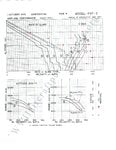davparlr
Senior Master Sergeant
In the Summer of 1942, and Winter of 1943, two aircraft were delivered to the American forces in the South Pacific that helped swing the momentum of the war in the Pacific, the P-38 Lightening and the F4U-1 Corsair. Both of these aircraft have characteristics that allowed them to be particularly effective. Here is a comparison of the two great aircraft,
.......................... F4U-1 – P-38G
Availability 2/12/43 - 8/22/42
Weight, Empty,lbs 8982 - 12,200
Weight, Gross 12,039 - 15,800
Weight, Max TO 14,000 - 19,800
Lift weight (max minus empty) 5,018 - 7600
HP available max 2000 - 2650 (two engines, 2x1325)
Power loading SL, gross, lbs/hp 6 - 5.9
Power loading, 20k ft.. 7.5 - 5.9
Wing area sqft 314 - 328
Wing loading. Lb/sqft, gross 38 - 44
Service Ceiling, ft. 37,000 - 39,000
Armament 6x50 cal, wing mounted - 4x50 cal, 1x20mm, nose mounted
Airspeed vs altitude
F4U-1 P-38G
SL 348 - 330
5k 344 - 345
10k 361 - 358
15k 378 - 383
20k 388 - 388
25k 392 - 403
climb (ft/min) vs. altitude
F4U-1 P-38G
SL 2900 - 3300
5k 2400 - 2850
10k 2300 - 2600
15k 2300 - 2600
20k 1700 - 2300
25k 1420 - 2000
The Zero could out turn either aircraft at all operational altitudes
The Zero could out climb the F4U at all altitudes
The F4U-1 could out turn the P-38 at all operational altitudes
The P-38G could out climb the F4U-1 at all operational altitudes
The P-38G and F4U-1 had similar airspeeds up to about 25k and easily surpassed the Zero.
Above 25k the F4U-1 airspeed and altitude starts to drop off rapidly relative to the P-38G.
With internal unprotected tanks, the F4U-1 had a considerable range advantage with internal fuel. There is a question of whether these tanks were used for combat.
Armament is similar, with the P-38 holding the edge due to center line mount and the additional 20 mm., which counted for 2 and ½ 50 cals per Navy estimate.
P-38 would require more pilot training/experience to understand the operational complexities and unique flying qualities of a twin engine aircraft.
Both of these aircraft were surprisingly similar in performance. They were both fast and had very good range than most enemy aircraft with the F4U-1 turning better and the P-38 climbing better. The P-38 does have better performance capability at the higher altitudes.
When operated with knowledgeable pilots, both aircraft were Japanese aircraft eating machines with both having good air-to-ground capability, with the P-38 having over a ton of additional lifting power. Both were powerful tools that helped push back the Japanese at the right time and right places.
Japanese aircraft shot down (didn't validate the source.)
F4U 2140
P-38 1857
Warbirds and Airshows- WWII US Aircraft Victories
Data taken from "wwiiaircraftperformance.org", "American Combat Planes" by Ray Wagner, "America's Hundred Thousand" by Dean, and "Report of Joint Fighter Conference" 1944. Oh, and some hair brained guesstimation on my part.
Knowledgeable corrections or opinions are appreciated.
.......................... F4U-1 – P-38G
Availability 2/12/43 - 8/22/42
Weight, Empty,lbs 8982 - 12,200
Weight, Gross 12,039 - 15,800
Weight, Max TO 14,000 - 19,800
Lift weight (max minus empty) 5,018 - 7600
HP available max 2000 - 2650 (two engines, 2x1325)
Power loading SL, gross, lbs/hp 6 - 5.9
Power loading, 20k ft.. 7.5 - 5.9
Wing area sqft 314 - 328
Wing loading. Lb/sqft, gross 38 - 44
Service Ceiling, ft. 37,000 - 39,000
Armament 6x50 cal, wing mounted - 4x50 cal, 1x20mm, nose mounted
Airspeed vs altitude
F4U-1 P-38G
SL 348 - 330
5k 344 - 345
10k 361 - 358
15k 378 - 383
20k 388 - 388
25k 392 - 403
climb (ft/min) vs. altitude
F4U-1 P-38G
SL 2900 - 3300
5k 2400 - 2850
10k 2300 - 2600
15k 2300 - 2600
20k 1700 - 2300
25k 1420 - 2000
The Zero could out turn either aircraft at all operational altitudes
The Zero could out climb the F4U at all altitudes
The F4U-1 could out turn the P-38 at all operational altitudes
The P-38G could out climb the F4U-1 at all operational altitudes
The P-38G and F4U-1 had similar airspeeds up to about 25k and easily surpassed the Zero.
Above 25k the F4U-1 airspeed and altitude starts to drop off rapidly relative to the P-38G.
With internal unprotected tanks, the F4U-1 had a considerable range advantage with internal fuel. There is a question of whether these tanks were used for combat.
Armament is similar, with the P-38 holding the edge due to center line mount and the additional 20 mm., which counted for 2 and ½ 50 cals per Navy estimate.
P-38 would require more pilot training/experience to understand the operational complexities and unique flying qualities of a twin engine aircraft.
Both of these aircraft were surprisingly similar in performance. They were both fast and had very good range than most enemy aircraft with the F4U-1 turning better and the P-38 climbing better. The P-38 does have better performance capability at the higher altitudes.
When operated with knowledgeable pilots, both aircraft were Japanese aircraft eating machines with both having good air-to-ground capability, with the P-38 having over a ton of additional lifting power. Both were powerful tools that helped push back the Japanese at the right time and right places.
Japanese aircraft shot down (didn't validate the source.)
F4U 2140
P-38 1857
Warbirds and Airshows- WWII US Aircraft Victories
Data taken from "wwiiaircraftperformance.org", "American Combat Planes" by Ray Wagner, "America's Hundred Thousand" by Dean, and "Report of Joint Fighter Conference" 1944. Oh, and some hair brained guesstimation on my part.
Knowledgeable corrections or opinions are appreciated.

